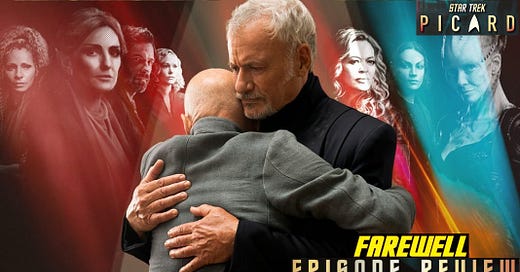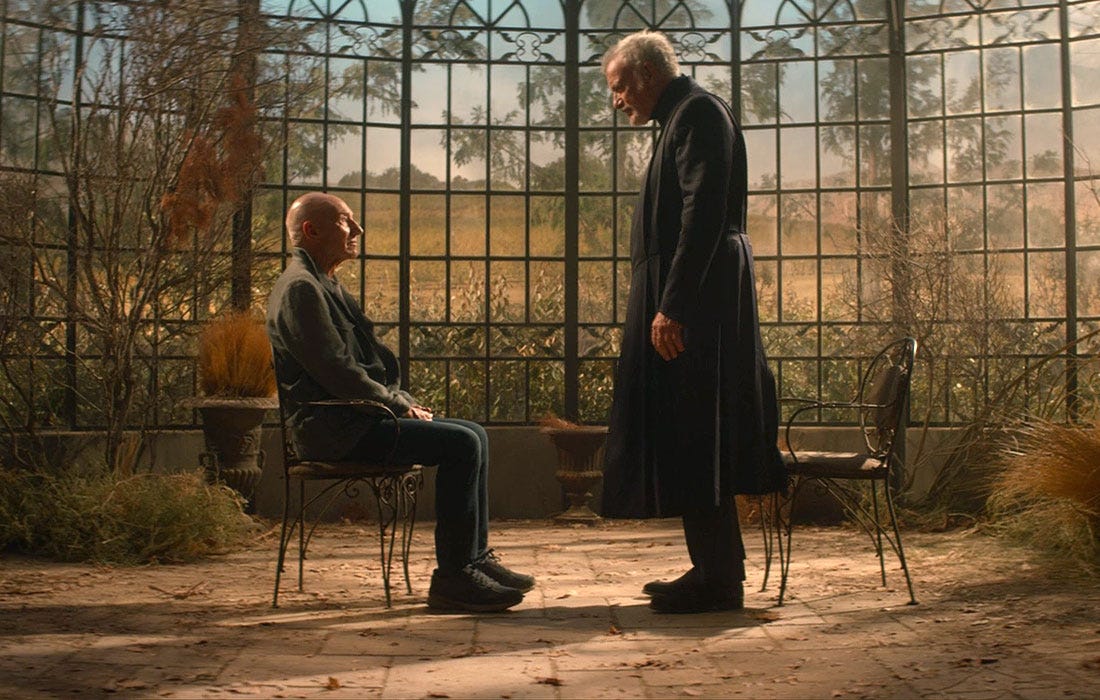You Say Goodbye & I Say Hello
Star Trek: Picard bids “Farewell” to a rocky, but worthwhile, sophomore season.
Star Trek: Picard
“Farewell”
Season 2, Episode 10 / Season 2 Finale
Written by Christopher Monfette & Akiva Goldsman
Directed by Michael Weaver
Starring Patrick Stewart, Orla Brady, Isa Briones, Santiago Cabrera, Evan Evagora, Michelle Hurd, Alison Pill, Jeri Ryan, and Brent Spiner
Guest Starring Steve Gutierrez, Penelope Mitchell, Sol Rodriguez, and Wil Wheaton
Special Guest Stars John de Lancie and Whoopi Goldberg
48 minutes
Original broadcast 5 May 2022
1. Slumps & Grumps
After Star Trek: Picard embarked upon its second season, my review of its premiere episode (“The Star Gazer”) argued that this outing helped Picard temporarily avoid the “sophomore slump” that bedevils so many television programs, movie sequels, second novels, follow-up stage plays, and, in far too many cases, American presidents during their second years and, should the electorate return them to the White House, second terms in office.
I still remember how, throughout the 1970s and 1980s, my Uncle Everett complained about how bad he thought Season 2 of his favorite program, the long-running Western Wagon Train (1957-1965), was despite Uncle Everett dutifully noting that Wagon Train should never have been cancelled and, for good measure, that if those damn-fool network executives who stupidly took it off the air wanted to restore justice and fairness to our troubled world, they’d return Wagon Train to television post-haste and let it run until the end of time or, at least, until the end of Uncle Everett’s life.
I don’t recall exactly what, in Uncle Everett’s studied opinion, went wrong with Wagon Train’s second year beyond his firm suspicions that 1) series star Ward Bond, a notorious alcoholic, arrived on set most days half-drunk (or “half-soused!” in Uncle Everett’s charming lexicon, at least when he—Everett—was feeling generous, as opposed to those times when, having enjoyed a few drinks himself, Everett—half-soused and feeling witty—proclaimed, “Ward fell off the wagon more than he was on it!”) and 2) that supporting cast-member Frank McGrath, who played amiable cook Charlie Wooster in 272 of Wagon Train’s 284 episodes (broadcast over eight seasons on two different networks), was a secret Communist sympathizer in league with fifth columnists trying “to destroy America’s way of life” (yes, Everett actually said those words aloud, but, to this day, I’m clueless about how he came to this conclusion about McGrath, one of midcentury American television’s best—if most underrated—actors, since Ward Bond was also a notorious anti-Communist who wouldn’t have allowed Pinko McGrath within ten miles of the production, so perhaps the truth about Everett’s opinions was as prosaic as could be, to wit: Everett, my pleasantly cantankerous uncle, was an ultra-proud Iowan who disliked all Missourians on principle, and poor Frank McGrath had the misfortune of being born and raised in Mound City, Missouri).
Let’s not talk about how the transition from Season 1 to Season 2 of Nic Pizzolatto’s True Detective (2014-Present) so enraged its fans that, had anyone burned Pizzolatto in effigy while HBO broadcast that year’s eight episodes throughout the summer of 2015, this roasting would’ve been mild compared to the online denunciations that Pizzolatto endured (some richly deserved, since hiring Vince Vaughn to play a California criminal mastermind remains one of the most disastrous casting decisions in television history).
I could cite other instances of fan discontentment with their favorite shows’ second go-rounds all day and all night, but four—no, make that five—examples nicely illustrate this trend: Lost Season 2? A step down from the heights of Season 1, even if not ruinously so, according to wide swathes of “Losties,” but don’t get them, or me, started on that terrible series finale.

Desperate Housewives Season 2? It’s fine, perhaps even underappreciated, but not a patch on the gloriously demented first year. Ditto Season 2 of Sleepy Hollow.
David Simon’s celebrated The Wire? Yep, because, as good as Season 2 may be, why go down to the Baltimore docks to tackle union corruption and what Simon called “the death of work”1 when Season 1’s epic parallel examinations of the Baltimore Police Department and Avon Barksdale’s illicit-drug organization became almost sublime in their narrative, thematic, and sociopolitical relevance?
And, in a case I’ve always considered as wrong as wrong can be, enough viewers of Chris Carter’s The X-Files follow-up program, the brilliantly crafted Millennium (1996-1999)—to date, the only weekly television series to star one of my favorite-ever actors, the redoubtable Lance Henriksen (in his now-signature role of criminal profiler Frank Black)—so vocally rebelled against this show’s mystical second season that some of them regard Year 2 as an extended hallucination whose events don’t count (meaning that only Seasons 1 and 3 qualify as real within Millennium’s fictional chronology) in the same way that the “it-was-all-a-dream” ninth season of David Jacobs’s 1978-1991 primetime soap opera Dallas erased everything that happened in its 31 episodes (apart from the Season 9 finale’s two concluding scenes). This perspective has obstinately survived from 1997 until the present moment, one-quarter of a century later, no matter how marvelous Millennium’s second year is (and, in a word, it’s terrific).
For comparison, how many movie sequels rank favorably next to their predecessors? Only a few leap to mind: 1963’s From Russia with Love? Well, clearly yes. 1974’s The Godfather Part II? Obviously. 1980’s The Empire Strikes Back? Indubitably. 1986’s Aliens? Undoubtedly. 2022’s Black Panther: Wakanda Forever? Close, but no cigar (despite its cast’s and crew’s valiant efforts).
Or, to return to the franchise that occasions this review, 1982’s Star Trek II: The Wrath of Khan? Most people say yes, but—prepare yourself, dear reader, for this against-the-grain opinion—I say no, even if The Wrath of Khan is very good indeed.
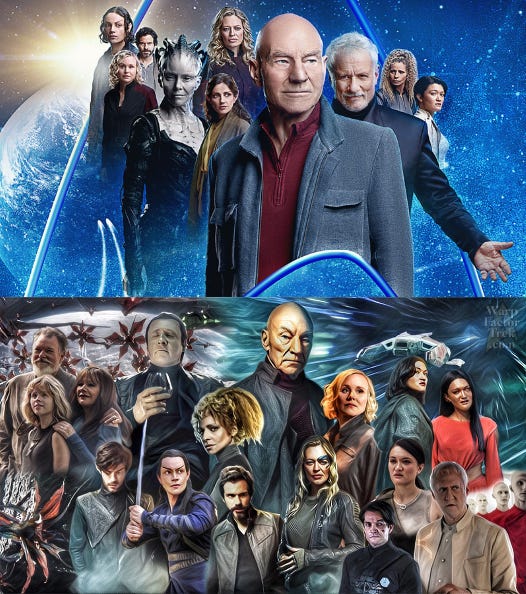
2. Grumps & Bumps
If we move from screen to page, the news is no better. Thomas Pynchon may agree with the critical drubbing that his 1966 novella The Crying of Lot 49 received, at least compared to the acclaim attending his 1963 debut novel V., with Pynchon writing in his introduction to Slow Learner, a 1984 collection of five early short stories, “As is clear from the up-and-down shape of my learning curve, however, it was too much to expect that I’d keep on for long in this positive or professional direction. The next story I wrote was ‘The Crying of Lot 49,’ which was marketed as a ‘novel,’ and in which I seem to have forgotten most of what I thought I’d learned up till then,”2 even if this confession is as ambiguous as everything else in Pynchon’s bibliography, wrapped in typically paradoxical prose that cloaks the pain about Lot 49’s cool reception that he may (or may not) feel—who’s to say?—inside an admission of fault that never quite concedes any blemish.
No matter how avidly some literary tastemakers celebrate Charles Dickens’s 1838 second novel Oliver Twist, this book will never escape the accusations of anti-Semitism lodged against it thanks to Dickens’s objectionable portrayal of Fagin, complaints that the author took seriously enough to stop the novel’s 1863 reprinting midway through, then alter the text that hadn’t already been set, to eliminate referring to Fagin as “the Jew” after Chapter 38.3
Apart from scholars of American literature, who remembers Herman Melville’s second novel, 1847’s Omoo, either as a sequel to his first (1846’s Typee: A Peep at Polynesian Life) or as a standalone volume that offers, to quote its subtitle, “a narrative of adventures in the South Seas”? And for the vanishingly few people who’ve actually read Omoo, the feeling of stepping down in quality from Typee may be unescapable, if not entirely deserved.
A notorious case of this trend finds fans of Joy Williams’s hallucinatory 1978 second novel The Changeling never having forgiven New York Times book critic Anatole Broyard for publishing a review so poisonous that The Changeling didn’t reach a second printing,4 a shocking development given how Williams’s debut novel, 1973’s State of Grace, was a 1974 National Book Award finalist.

Even Star Trek: Picard co-creator Michael Chabon’s satirical (and successful) second novel, 1995’s Wonder Boys, pokes fun at the entire phenomenon of second novels being harder to write—and always worse—than their antecedents by telling the story of Grady Tripp, a Pittsburgh, Pennsylvania creative-writing professor whose mammoth (2,611-page!) manuscript for the follow-up effort to his award-winning first novel escapes Tripp’s control and nearly ruins his life, a plot inspired by Chabon’s own struggles with his first second novel (meaning the first manuscript he began after the success of 1988’s The Mysteries of Pittsburgh, Chabon’s first actual novel—got that?), a never-seen tome that, as Vogue’s deputy editor Taylor Antrim memorably explains, only came to fruition after Chabon “spent nearly five years piling up a 1,500-page shipwreck of a second novel called Fountain City”5 before Chabon chucked all those pages, paragraphs, and words into a drawer and churned out Wonder Boys, which totals only 368 pages in its first (hardback) edition and which screenwriter Steve Kloves, director Curtis Hanson, and a talented cast then adapted into the 2000 film (of the same title) that netted Bob Dylan both the Academy and Golden Globe Awards for Best Song (“Things Have Changed”).
Broadway hasn’t avoided “sophomore slump-itis” any better than Hollywood or the publishing industry, either. The writing team behind 1960’s Bye Bye Birdie, for instance, created a sequel show, Bring Back Birdie, so unpopular that Bring Back Birdie closed only four performances—and two days—after its 5 March 1981 premiere despite star Chita Rivera returning to the lead role of Rose Alvarez two decades after her Tony Award-nominated performance in the original musical (and netting her another Tony nomination in the process).
How many people know that Birdie composer Charles Strouse tempted fate—and initially lost—by writing not one, but two sequels to his 1977 mega-hit Annie? The first, 1989’s Annie 2: Miss Hannigan’s Revenge, was abandoned after disastrous try-outs in Washington, D.C. scuttled plans to open on Broadway (or anywhere else), while, in a happier-than-expected conclusion to this sad tale, Strouse’s actual sequel, Annie Warbucks, premiered off-Broadway, at New York City’s Variety Arts Theatre, on 9 August 1993 and ran for 200 performances.
Did you realize that The Best Little Whorehouse Goes Public, the misbegotten follow-on to 1978’s hit musical The Best Little Whorehouse in Texas, ran for only two weeks in May 1994? No? Well, let’s all breathe sighs of relief that a sequel to the 1982 film adaptation of Texas, bearing whatever title, has never been attempted.
No less than Andrew Lloyd Webber tried to continue 1986’s The Phantom of the Opera (still the longest-running show in Broadway’s history, amassing 13,981 performances at NYC’s Majestic Theatre over the span of 35 years, from 26 January 1988 to 16 April 2023)6 in the ironically titled Love Never Dies, which opened in 2010 to such dismal critical reviews and unkind audience responses that it’s never played on Broadway, although Webber’s heavily re-worked 2011 version—first performed in Australia—has seen steady business all around the world (and still hasn’t officially closed).

The point of this long perambulation through the difficulties of mounting a worthy second production (in any genre, mode, or media) is, simply, to demonstrate how well Star Trek: Picard’s second season stacks up against its first, which accrued plenty of its own skeptics within the cantankerous Trek fanbase, although I’m not one of them.
To my mind, Season 1 is good—and occasionally great (see its seventh episode, the masterful “Nepenthe”)—even if it concludes on tenterhooks in an oddly fascinating two-part finale (“Et in Arcadia Ego”) that includes developments so searing in their beauty that they’re indelible (especially Jean-Luc Picard’s deeply touching and brilliantly performed final conversation with a quantum-stored version of the android Data’s consciousness); events so trippy that they can only happen in Star Trek (see the gigantic space orchids that bring down a Borg cube in a sequence that, deliberately or not, recalls “Beyond the Farthest Star,” the premiere episode of 1973-1974’s Star Trek: The Animated Series); and head-scratching plot points that make little sense if you think about them for more than ten seconds (i.e., Captain William T. Riker’s convenient “copy-and-paste” fleet of two-dozen Inquiry-class starships that arrives—you guessed it—in the nick of time; the fact that Riker permits the Romulan commander of the opposing fleet, the traitorous Commodore Oh, to go free without attempting to bring her to justice for the many crimes she’s committed against the Federation, including perpetrating a massacre on Mars that gets all synthetic lifeforms banned; and an ancient—and possibly trans-dimensional—“alliance of synths” so hostile to organic life that, notwithstanding a promise to exterminate all organic intelligence in the galaxy, inexplicably chooses not to open a portal of its own after the spatial rift through which it’s entering normal space prematurely closes).
Unlike this Season 1 finale and despite my reservations about Season 2’s regrettable narrative developments, none more acute than the suicide of Yvette Picard (Madeline Wise), I’ve found myself moved by Year 2’s fearless exploration of Jean-Luc Picard’s (Sir Patrick Stewart’s) childhood traumas and impressed by the writing staff’s willingness to take chances with several just-this-side-of-absurd turns in Season 2’s timey-wimey storyline. So, now that we’ve arrived at the appropriately titled “Farewell,” the burning questions are: How good is it? How satisfying a final hour does this finale offer? And how well does “Farewell” wrap up an uneven, if worthwhile, season?
I’m happy to report, dear reader, that the answer to all three queries is: Fine, just fine, and thank you for asking.

3. Hello, Jean-Luc
All is not perfect, I hasten to add, but, then again, all is never perfect, is it? “Farewell’s” lesser aspects derive from the dodgy creative decisions that co-showrunners Terry Matalas and Akiva Goldsman make in the previous nine episodes, even if no single choice can—or does—sink Season 2’s narrative enterprise (a terrible pun, isn’t it, but one I never can avoid).
I needn’t belabor my complaints about Yvette’s suicide (see my previous review, “Sieges & Sorrows”), although this tragedy at least yields worthwhile emotional reverberations that lead Jean-Luc to a cosmically necessary, if resolutely grim, personal decision that closes Year 2 with as much melancholy as triumph. Star Trek: Picard Season 2, in other words, doesn’t ignore its major storyline’s most significant consequences in favor of simple resolutions, happy endings, or easy victories.
Quite the opposite if we consider how skillfully “Farewell” knits this season’s many subplots into a tapestry that justifies our faith—or, at least, my faith—that Year 2’s many invocations of Star Trek: The Next Generation’s Season 6 masterpiece “Tapestry” could (and would) pay handsome dividends. “Farewell,” to switch from financial metaphors to spiritual similes, plays out like a televisual kōan whose paradoxes—a kinder term, certainly, than contradictions—force grudging enlightenment upon Picard, and upon us, that we may not wish to acknowledge, but whose acceptance is, finally, the point toward which we’ve been moving all along. This knowledge of self, in other words, may not come willingly or joyfully, but arrive it does no matter Jean-Luc’s doubts, fears, or anxieties.
If that judgment sounds like so much airy-fairy, artsy-fartsy nonsense, take heart that “Farewell” is remarkably fleet of foot, requiring only 48 minutes to bring Picard Season 2 to a (mostly) satisfying conclusion. This finale doesn’t overstay its welcome or meander around the landscape, but instead ties up many loose ends while still commenting upon life, the universe, and everything. Writers Christopher Monfette and Akiva Goldsman can’t avoid such philosophical notions (what would Star Trek be without them?), particularly considering how ruminative Jean-Luc Picard has become in his advanced years, beyond even his TNG-era thoughtfulness (where Picard’s speeches about truth, duty, and honor are plentiful enough that John de Lancie’s galactic trickster Q more than once mocks them).
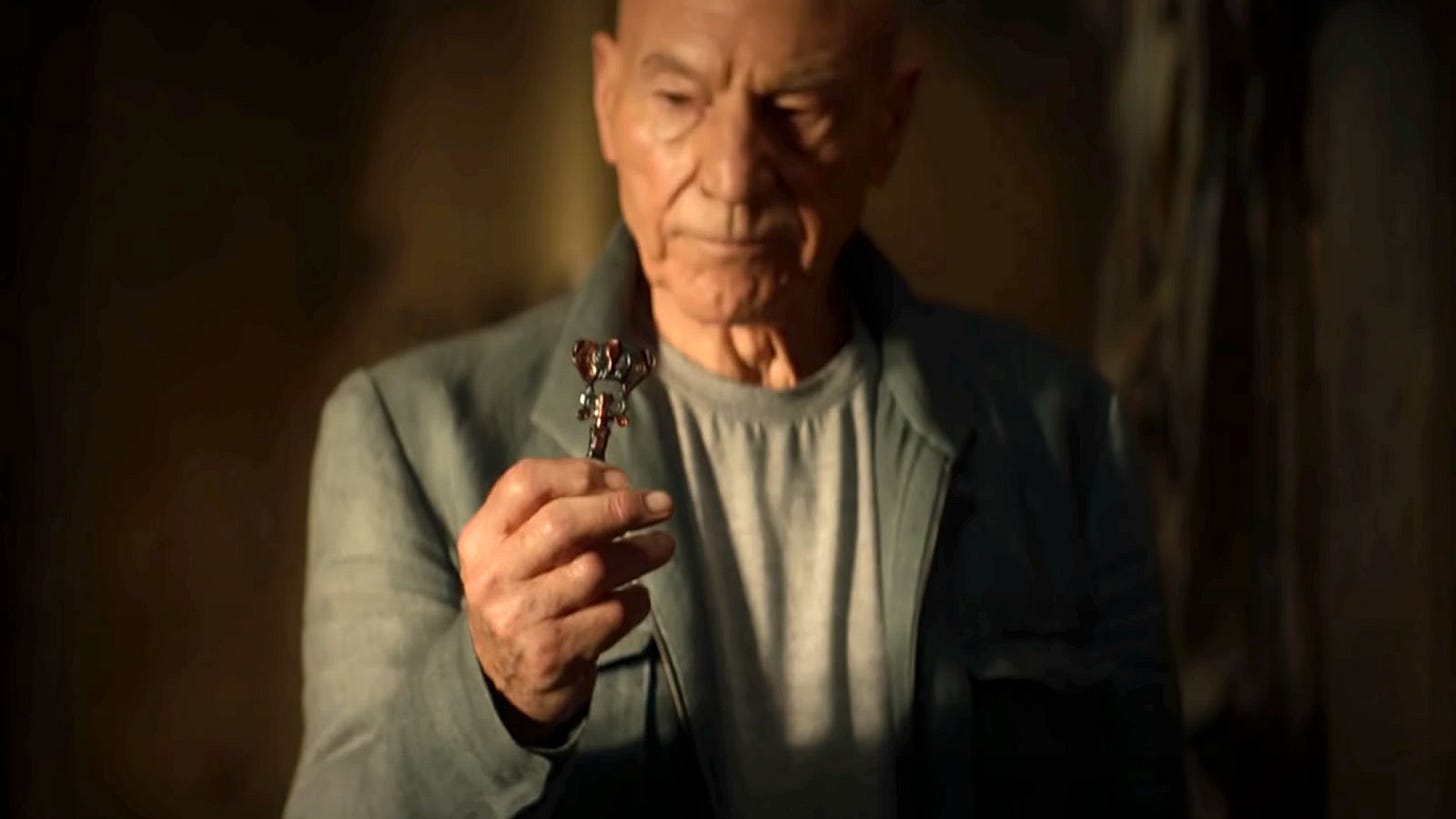
No reason exists to feel gun-shy about exploring larger issues within Year 2’s time-tripping adventures, although Monfette and Goldsman aren’t composing speeches for a debating club, but rather an hour of television that must bring Picard’s—and Picard’s—Season 2 journeys to resolution, if not closure. “Farewell” hits all the required beats, with Picard and his La Sirena shipmates returning to 2024 Los Angeles to ensure that the Europa Mission spacecraft (whose crew includes Jean-Luc’s ancestor, the astronaut and mission specialist Renée Picard, played by Penelope Mitchell) launches on time and without interference by the machinations of Data’s ancestor, the amoral Dr. Adam Soong (Brent Spiner).
This outcome, however, demands loss, with Orla Brady’s Romulan guardian Tallinn finally revealing herself to Renée—the woman whom Tallinn’s observed for decades—just before Renée leaves the Europa Mission’s mandatory quarantine to ride its Shango X-1 craft to Jupiter’s moons, where she’ll discover a sentient extraterrestrial microorganism that will permit humanity to clean Earth’s atmosphere and oceans of the pollution that threatens the planet’s ecological balance—and that, this episode implies, will help humanity, four or five decades later, heal the shattered Earth after a nuclear war devastates so much of the surface that people will be reduced to living in ragtag encampments (as seen by Picard and the crew of the U.S.S. Enterprise-D in TNG’s pilot episode, “Encounter at Farpoint,” and by the crew of the Enterprise-E in the franchise’s eighth film, 1996’s Star Trek: First Contact).
Tallinn’s destiny is to die in Renée’s place. She (Tallinn) outwits the venal Soong by wearing a holographic mask of Renée’s face that fools Soong into poisoning her (Tallinn) with a neurotoxin embedded in a false layer of skin covering his left hand. Picard finds the fallen Tallinn too late, but Orla Brady plays her character’s death so tenderly, with so much hope for the future and so much contentment at completing her mission (of protecting Renée’s life), that we barely notice how Star Trek: Picard kills off its second significant female character in as many weeks. Unlike Yvette’s death in Episode 9 (“Hide and Seek”), however, “Farewell” earns the emotional heft that Tallinn’s sacrifice represents by fulfilling an outcome that’s been suggested since this character’s introduction in Episode 4 (“Watcher”).
Brady and Stewart break this viewer’s heart when parting from one another, with Tallinn dying as bravely as she lived. If she must perish, her heroic sacrifice here is far preferable to Yvette’s Episode 9 exit, with longtime viewers witnessing a welcome callback to another classic Next Generation installment, Season 5’s “The Inner Light,” when the dying Tallinn watches the Shango rocket launch skyward, just as, in the earlier episode, Picard—living the imagined existence of a villager named Kamin on the long-dead planet Kataan—watches a missile fire into the air as his virtual life ends.
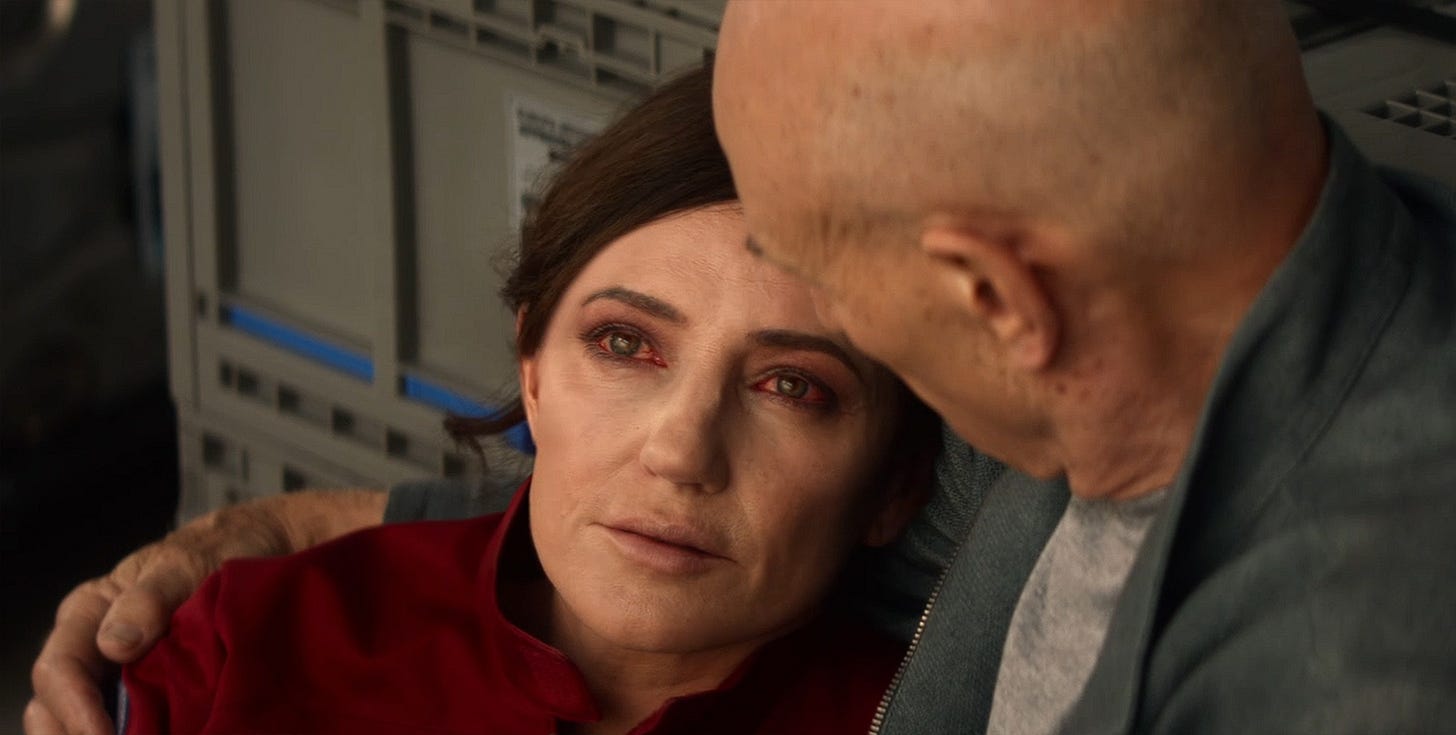
Even better, the dialogue that Monfette and Goldsman give Brady plumbs the profound effects that death has on us all. “The secrets we keep,” Tallinn tells Jean-Luc, “the reasons we never tell someone we love them, they’re worthless. Sweet Picard, your guilt must have saved planets by now. Countless lives in trade for the one you couldn’t.” If, dear reader, you’ve ever lost a parent, these words resonate with the grief and despair that can overwhelm those of us left behind. “I know that she (Renée) was worth all of it,” Tallinn says, adding, “You (Jean-Luc) helped me give that to her. Absolve yourself or the only life left unsaved will be your own.” Tallinn’s wisdom upon passing into the undiscovered country provokes such silent compassion from Picard that we again realize—not that we needed more evidence—how wonderful an actor Patrick Stewart is. And Orla Brady is every bit his equal.
These themes—of bravery in the face of death, of gratitude for the gift of life, of forgiveness in the wake of remorse—lead to even more touching scenes in “Farewell” that are, for my money, among Season 2’s best. Picard takes an ornate skeleton key that, toward Episode 9’s conclusion, he finds on the floor of Château Picard’s solarium and hides it inside a wall. Doing so in 2024 ensures that his boyhood self (Dylan Von Halle) will, four centuries hence, use this key to release Yvette from the room where Jean-Luc’s father, Maurice (James Callis), traps her for fear that Yvette will harm herself while suffering a bout of mania.
Picard erroneously thinks that freeing his mother from this cruel captivity pushes Yvette to end her life. Fulfilling his historical duty not to change the past in any way, as difficult as this task may be, ensures that Jean-Luc must continue living with the misdirected guilt that he’s felt for decades and, sadly, that he always will feel.
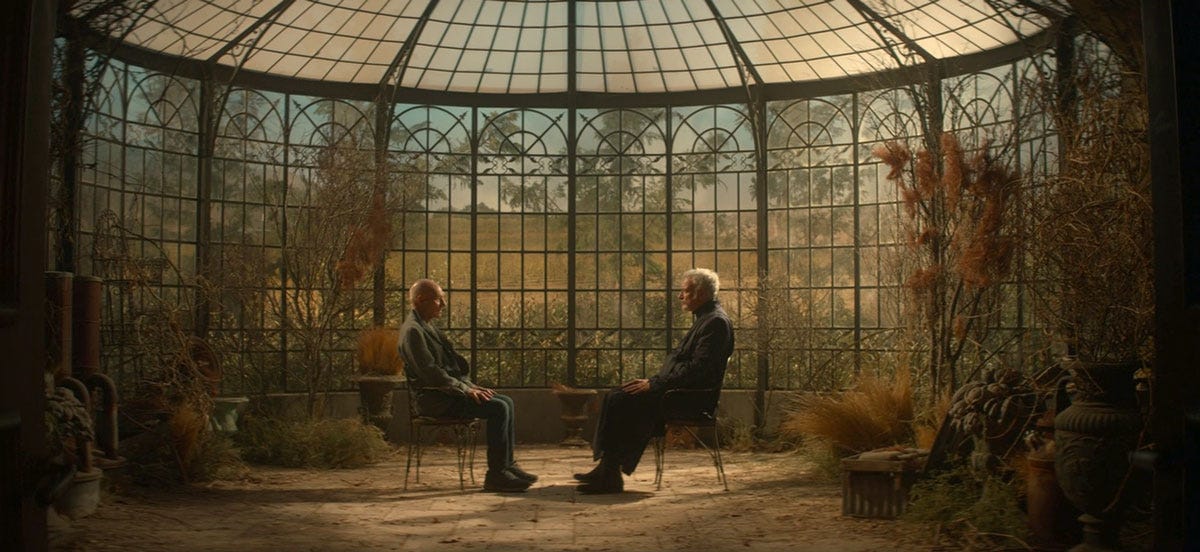
4. Goodbye, Q
This action brings Q back into the fold, hoping to teach Picard emotionally potent truths, primarily that he—Jean-Luc—isn’t responsible for his mother’s death. Even so, by condemning himself to think that he is, Picard tragically creates the conditions that make it possible for him to honor Tallinn’s request that he unburden his mind and his soul of a lifetime of recrimination. This paradox demonstrates Q’s wisdom in creating the terrible alternate history that Year 2 dramatizes, redeeming his choice to allow this fascistic parallel world not merely to exist, but to replace Picard’s primary reality. Q’s angry determination to force not merely Picard, but everyone else, to suffer this new timeline implies, from Episode 2 (“Penance”) onward, that Q’s become a full-on psychopath. His willingness to sacrifice the lives of all other people on the altar of a private lesson for Picard may raise the stakes seen in “Tapestry” to galaxy-spanning proportions, but endangering the future of so many people for the good of one seems extraordinarily callous, even for Q.
Seems is the operative word here given that Q’s behavior makes sense insofar as he confesses, in Episode 8 (“Mercy”), that he’s dying—or what he calls being “on the threshold of the unknowable”—in an obscure, but heady, reference to Star Trek: Voyager’s Season 2 tour-de-force “Death Wish,” in which Captain Kathryn Janeway (Kate Mulgrew) learns that the Q Continuum isn’t as fabulous as claimed. A renegade Continuum resident calling himself Quinn (Gerritt Graham) wishes to kill himself, provoking a swift counter-reaction that sees de Lancie’s Q arrive aboard the U.S.S. Voyager as the Continuum’s representative, arguing for “the majesty of life” in a bid to deny Quinn’s choice to commit suicide.
Quinn, however, reveals that the Continuum’s omniscient citizens, having experienced everything that can be experienced and said everything that can be said, are now a bored, listless people whose culture calcifies the point that Q himself defies this stagnation. “Death Wish” reveals that Q’s sporadic appearances as the galaxy’s ultimate trickster-troublemaker in The Next Generation (1987-1994) and Deep Space Nine (1993-1999) stem from his refusal to endure the living death that residing in the Continuum represents.
Rebelling against a system whose cosmic indifference removes all passion and joy from life, Q’s choice to tear across the universe, interfering in the fates of entire species, brings added weight to his determination in Picard Season 2 to relieve Jean-Luc of the admiral’s lifelong emotional and spiritual scars. De Lancie’s brilliance as Q across 35 years of Trek storytelling so far outstrips his onscreen appearances (in only 20 episodes of five different series: TNG, DS9, Voyager, Lower Decks, and Picard) that his last scenes with Stewart are what I can only call barnburners.
During their final conversation in Château Picard’s solarium, sitting in chairs facing one another, Q tells Picard that the admiral, by choosing not to change his or his mother’s fate, has now absolved himself of guilt and made himself worthy of love, which allows Q to move onto death—not exactly a Quinn-style suicide, we sense, but also not an event fully in Q’s control, either—with as close to a clear conscience as Q can achieve. When Picard wonders why Q would take the trouble to help him (Jean-Luc) this way, de Lancie gives another magnificent performance (in a Trek career studded with them) by summoning the same combination of affection and annoyance seen during Q’s final appearance in “All Good Things…,” TNG’s series finale, to illustrate how the trial of humanity that began in “Farpoint” has been a trial of Picard’s personal humanity as much as the species’ existence.
In “All Good Things…,” Q says, after Picard realizes the implications of a temporal paradox that Q creates at the Continuum’s behest, “That is the exploration that awaits you. Not mapping stars and studying nebulae, but charting the unknown possibilities of existence.” Q’s words to Picard in “Farewell” make good on this promise (just as his appearances throughout Picard Year 2 fulfill his assurance in “All Good Things…” that, “if you’re very lucky, I’ll drop by to say ‘hello’ from time to time. See you out there”), with Q stating, in dialogue so good it’s worth quoting in full, “I am dying alone. I do not want that for you. Humans: your griefs, your pains fix you to moments in the past long gone. You’re like butterflies with your wings pinned. My old friend, forever the boy, who with an errant turn of a skeleton key, broke the universe and his own heart, no more. You are now unshackled from the past. As I leave, I leave you free.”
Dear reader, if I assure you that de Lancie’s fantastic work here doesn’t make my eyes wet, will you believe me? Do you dare question my fortitude when, after Picard asks if something’s about to happen that requires his (Picard’s) presence, Q chides Picard for thinking that the universe revolves around him, inquiring “Must it always have galactic import?” even though the scenario Q constructs for Picard in Season 2 seems to have exactly that?
“Universal stakes? Celestial upheaval? Isn’t one life enough?” Q asks. Then, in moments that soften my grizzled old cynic’s heart, Q offers these parting thoughts: “You ask me why it matters. It matters to me. You matter to me. Even gods have favorites, Jean-Luc, and you’ve always been one of mine.” Q rises from his chair midway through this speech to place both hands on Picard’s face in a tender gesture that director Michael Weaver films in superb close-ups, allowing de Lancie’s and Stewart’s performances to dominate the screen.

Composer Jeff Russo’s music offers gentle counterpoint to the profound feelings displayed here, with Q’s trial reaching its conclusion by offering Picard unexpected grace. The long relationship between these characters (and their actors) is impossible to miss, testifying to how well Monfette and Goldsman understand the details of Q’s and Picard’s rapport, which they bring to elegant conclusion in the next two scenes. After Q declares, “Farewell, mon capitaine. It’s time for me to go,” Picard replies, “But not alone. Isn’t that the point of all this?” Then, when Jean-Luc hugs Q, we see Q’s/de Lancie’s eyes briefly mist, as do mine.
And if yours don’t, dear reader, let’s just acknowledge, right here and now, that you’re made of sterner stuff than I am.
Despite my impulse to shout “Hear hear!” before declaring all else in “Farewell” mere filler, de Lancie and Stewart couldn’t generate this emotional power if Picard Season 2 didn’t build sufficient scaffolding to make their final interaction so special.
Put another way, on this score, “Farewell” is a splendid success.
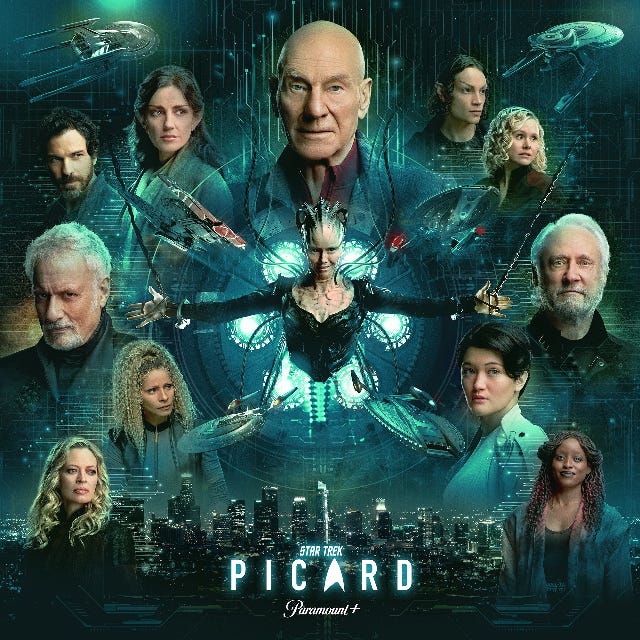
5. Farewell, Season 2
Everything else nicely slots together. Cristóbal Rios (Santiago Cabrera) elects to remain in the 21st Century with Dr. Teresa Ramirez (Sol Rodriguez) and her son, Ricardo (Steve Gutierrez), freeing enough “surplus energy” for Q to offer the remaining La Sirena crew members—Picard, Raffi Musiker (Michelle Hurd), and Seven of Nine (Jeri Ryan)—the gift of returning the dead Elnor (Evan Evagora) to life when Q restores them, in reset-button fashion, to the bridge of the U.S.S. Stargazer minutes before its destruction (namely, the event that, in Episode 1, kicks off this season’s alternate-history plot).
Yet Monfette and Goldsman are good enough to catch us up with Koré Soong (Isa Briones), Adam’s clone daughter, before we resume Square One. Koré walks away from her father once and for all, then receives a cryptic message from a person who turns out to be (drumroll, please) . . . Wesley Crusher (Wil Wheaton)!
Bet you didn’t see that one coming, dear reader, and for good reason. Wesley’s now a Traveler in space and time, exactly like the character played by Erik Menyuk in three TNG outings (Season 1’s “Where No One Has Gone Before,” Season 4’s “Remember Me,” and Season 7’s “Journey’s End”). Calling Wesley back to onscreen Trek for the first time since his cameo in the franchise’s tenth film, 2002’s Star Trek: Nemesis, is among the deepest cuts of nostalgia that Monfette and Goldsman could’ve indulged.
I whooped aloud to see the bearded Wheaton amble into view. This pleasant surprise nonetheless feels rushed, as if Monfette and Goldsman shoehorn it into Year 2’s finale in a mad dash to dot every I and cross every T on their Trek wish-list, in a storytelling approach that, no matter the conveniences upon which it depends, still offers agreeable results. I won’t quibble too much since, no matter how random Wesley’s re-appearance might seem, Wheaton looks terrific, establishes immediate chemistry with Briones, and shows how good an actor he can be when given the proper material.
Rather than contacting Picard, Wesley—sorry, make that the Traveler (or a Traveler?), since, as the man says, “a long time ago, I was known as Wesley Crusher”—whatever his name may now be, this person tells Koré that he and his trans-temporal colleagues “dispatch those we call Supervisors” (i.e., Tallinn) “to help ensure the proper flow of time.” With this revelation, the Wesley Traveler renews Picard Season 2’s debt to Terry Matalas’s previous series, the SyFy Channel’s excellent 2015-2018 televisual adaptation of Terry Gilliam’s 1995 film 12 Monkeys, which posits the existence of “Primaries,” evolved human beings whose deep connections to time (or Time with a Capital-T, which becomes a living, sentient force in 12 Monkeys) help Time not merely function but indeed think for itself (or Itself).
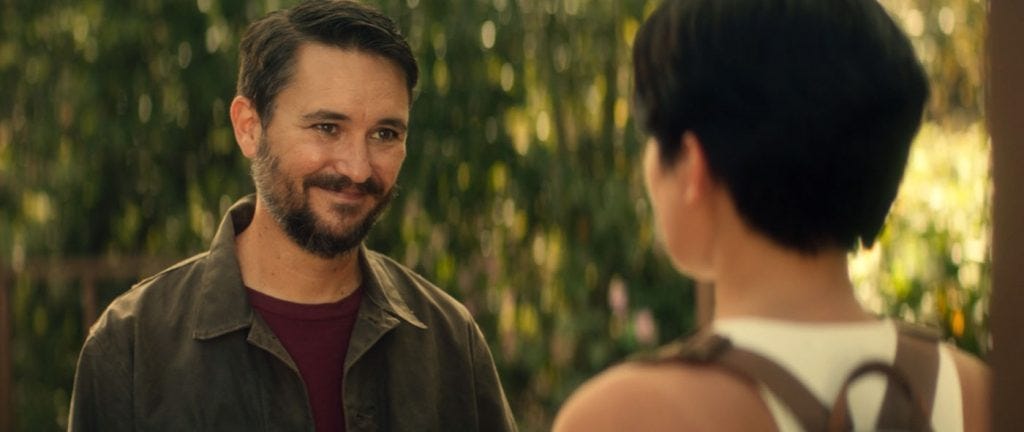
The Travelers provide similar services for Star Trek, with Wesley telling Koré, “The universe is essentially a grand tapestry” (didn’t I say so?). “It is flawless. It is fragile. It is exquisite. Yet it is somehow always a thread’s pull away from annihilation,” which, if true, suggests that the universe isn’t flawless no matter how poetic Wesley’s words may be. This speech also hints that Picard was always destined to pass Q’s test, since, if not, wouldn’t the Travelers and Supervisors have intervened to prevent—or try to prevent—Q’s Confederation of Earth timeline from coming to pass?
Perhaps we shouldn’t ponder these imponderables too long. Wesley, rather than dwelling on them, recruits Koré into the Travelers’ ranks, oddly opting not to meet Picard (or even mention his mother, Beverly Crusher, remember her?). And precisely what qualifies Koré to be a Traveler remains a mystery, although Koré’s intelligent determination to discover her origins as a clone commends her ability to accept possibilities that other people might reject out of hand.
This scene, richer in character development and thematic relevance than plot logic, resembles much of Picard Season 2. That’s not a backhanded compliment, either, since I’m all for grounding Trek’s stories this way whenever possible. If Monfette, Goldsman, and Matalas wish to connect so many aspects of the franchise’s lore by associating Picard’s temporal minders with TNG’s Travelers and TOS’s Supervisors (stretching, in this case, all the way back to TOS’s Season 2 finale, “Assignment: Earth,” and its principal guest character, Robert Lansing’s Gary Seven), good for them.
We know—thanks to Voyager’s Season 3 two-parter “Future’s End” and its Season 5 episode “Relativity,” as well as the eight Star Trek: Enterprise installments featuring Matt Winston’s temporal agent Daniels—that, by the 29th Century, the Federation will establish its own time-preservation agency to keep history on track. Wesley Crusher’s revelations about the Travelers’ objectives in “Farewell” modify our understanding of how the Trek universe operates, so it’s nice to know that the franchise’s version of Doctor Who’s Time Lords is in such congenial hands.
And so it goes during the closing scenes and moments of “Farewell.” We see the new, hybrid Borg Queen—with Agnes Jurati’s (Alison Pill’s) face—helping Starfleet fend off a gigantic energy discharge from a transwarp conduit of unknown origin that promises greater threats to come. The Jurati Queen petitions the Federation for her Collective’s provisional entry and membership, then promises to watch over this new spatial conduit as a cosmic “guardian at the gates.”
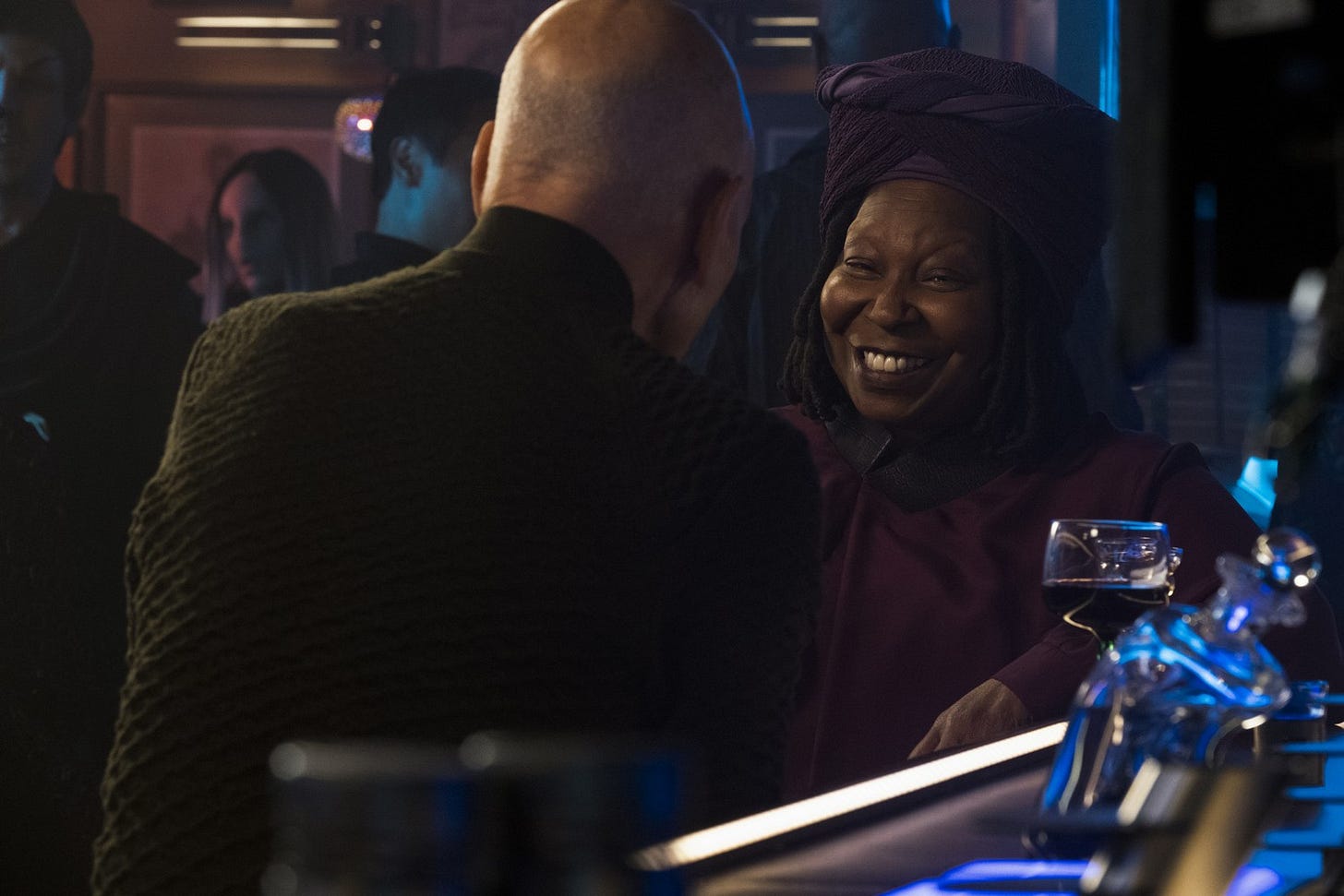
Picard then visits the 25th Century Ten Forward Bar, where we see Whoopi Goldberg’s Guinan for the first time since Episode 1. She tells Jean-Luc that, for fear of changing history, she couldn’t cop to knowing that Rios would remain in the past, where he and Teresa founded a Médecins Sans Frontières-like movement called the Mariposas, where Ricardo assembled the team that discovered how to use the alien microorganism brought back to Earth by his “Aunty” Renée, and where all these people become close friends, meaning that, at far as Star Trek: Picard Season 2 is concerned, the universe truly does revolve around Jean-Luc.
Patrick Stewart and Whoopi Goldberg share the same wonderful chemistry they always have, which helpfully obscures 1) Guinan’s primary function as an exposition machine and 2) how small the circle of Season 2’s dramatis personae is. Goldberg may only have been available for one or two days to film her scenes in “The Star Gazer” and “Farewell,” so I shan’t grumble about her brief screentime.
Monfette and Goldsman, therefore, pay off every major Season 2 plot point, and even a few minor ones, in “Farewell.” Depending upon one’s perspective, this achievement is a tremendous narrative coup that manages to wrangle, then to tame, this unruly year’s disparate storylines into passable shape or, to the less-charitably minded, an uncomfortable reminder that Picard Season 2 bites off more than it can profitably chew in 10 episodes, leaving Monfette and Goldsman to prepare a dish whose narrative flavors, they hope, cook into an appetizing, or at least palatable, stew.
How successful are they? This question provokes a dozen more: Does Star Trek: Picard Year 2 include too many conveniences, contrivances, and coincidences? Does it too mechanically impose a sequence of events that disregards life’s essential randomness? Does it qualify as an example of televisual postmodernism whose odd sense of dream logic values the paradoxical and the intuitive over the linear and the rational? Are its narrative choices too nonsensical? Too traditional? Too incoherent? Too coherent? Is it a good story? Is it a mess?
Saying that Star Trek: Picard’s second season contains all these multitudes would be a critical cop-out of the highest (or is that lowest?) order, so, dear reader, I’m not avoiding the question by confessing that Year 2 has, by turns, infuriated me, impressed me, perplexed me, delighted me, irritated me, and enthralled me. Yet it’s never failed to entertain me, so, in the end, I recommend it to everyone. Season 2 gives us so much to contemplate and to appreciate that I can’t help but like it a great deal, meaning that I firmly disagree with people who say it’s not worth the viewer’s time.
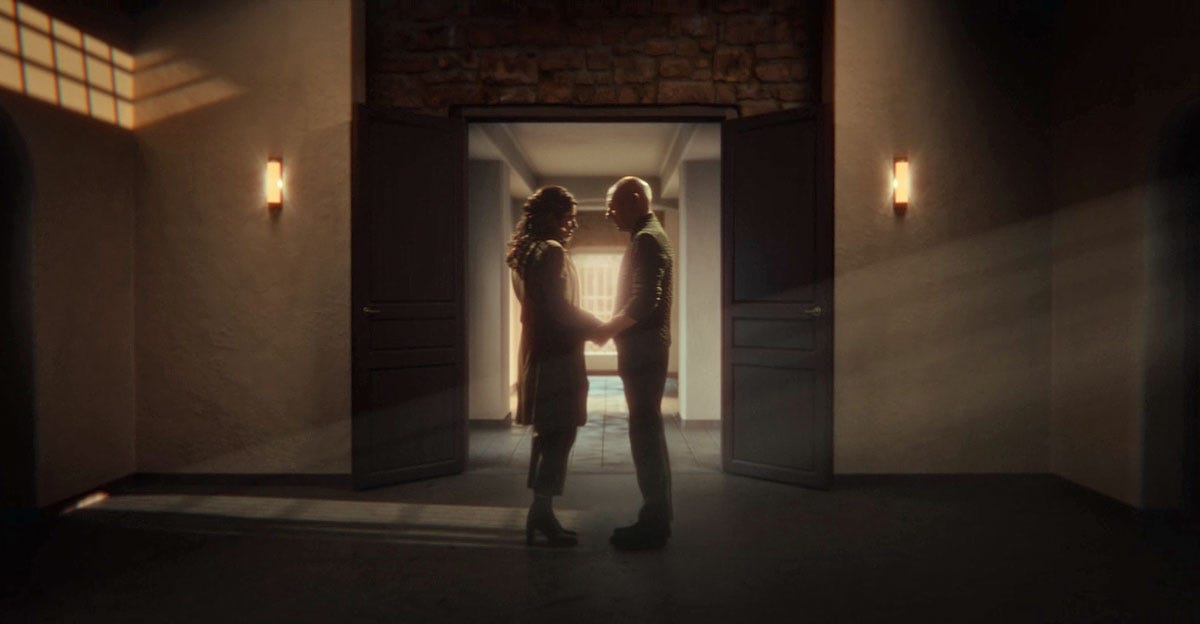
And I have only compliments for Year 2’s final scene, in which Jean-Luc Picard takes to heart Q’s advice about becoming worthy of love. Finding Laris in Château Picard’s solarium, Picard realizes that he must reveal his feelings when Laris bids him farewell, telling Picard, “I’m going on adventures of my own.” Rather than directly confessing his feelings, Jean-Luc says, having learned the lessons of Season 2, “There are moments in our lives we fear to relive and others we long to repeat. While time cannot give us second chances, maybe people can.” Stewart and Brady are excellent here, staring directly into one another’s eyes, measuring each other’s sincerity, and listening—truly, intently listening—to the other speak.
How lovely that this action-packed season concludes with such intimate emotion. The hope—and slight fear—in Picard’s eyes, as well as the dawning recognition in Laris’s when she realizes what he’s telling her, are magic. We don’t hear what Picard says next, but that’s okay, because we already know what’s happening. As the camera pulls up and away, out of the solarium, “Farewell” looks heavenward, to the stars—to the infinite cosmos—as Alexander Courage’s Star Trek fanfare sounds.
Yes, it’s majestic. Yes, it’s inspiring. And yes, it’s designed to tug our heartstrings exactly as it does, so we’re lucky that Patrick Stewart and Orla Brady are gifted actors, that Michael Weaver is an excellent director, and that Jeff Russo is as fine a composer as he is. By expertly plucking every single string, they leave us—or, at least, leave me—feeling complete, whole, even peaceful.
For that accomplishment alone, I offer my thanks to everyone involved in creating this second year of Star Trek: Picard.
And, as my reviews of Picard’s sophomore season now cross the finish line, I say to you, dear reader, with all the good cheer and warm feelings I can muster, amen.
FILES
NOTES
David Simon, introduction to “The Wire”: Truth Be Told by Rafael Alvarez, 2nd edition, Grove Press, 2009, pg. 11.
In this book’s first edition (published by Pocket Books in 2004), Simon refers to The Wire’s second season as chronicling “the death of work” on Page 12.
Thomas Pynchon, introduction to Slow Learner: Early Stories, Little Brown and Company, 1984, pg. 22.
Paul Vallely, “Dickens’ Greatest Villain: The Faces of Fagin,” Independent, 7 October 2005, https://web.archive.org/web/20081205101924/http://www.independent.co.uk/arts-entertainment/films/features/dickens-greatest-villain-the-faces-of-fagin-509906.html.
Dwight Garner, “Joy Williams’s 30-Year-Old Comeback Novel,” New York Times, 21 April 2008, https://archive.nytimes.com/artsbeat.blogs.nytimes.com/2008/04/21/joy-williamss-30-year-old-comeback-novel/.
Anatole Broyard’s original, bruising review of Williams’s The Changeling, published on 3 June 1978 under the anodyne title “Books of the Times: New Joy Williams Novel,” is available at https://www.nytimes.com/1978/06/03/archives/books-of-the-times-new-joy-williams-novel-an-arbitrary-muddle-a.html.
Taylor Antrim, “When Second Novels Go Bad,” Los Angeles Times, 3 May 2009, https://www.latimes.com/entertainment/arts/la-caw-off-the-shelf3-2009may03-story.html.
The Phantom of the Opera, Internet Broadway Database (IBDB), https://www.ibdb.com/broadway-production/the-phantom-of-the-opera-4491.

